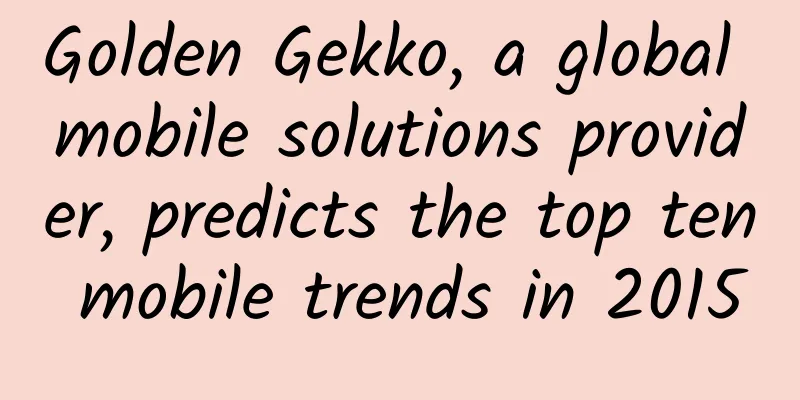Golden Gekko, a global mobile solutions provider, predicts the top ten mobile trends in 2015

|
I got an internal forecast from Golden Gekko, a global mobile solution provider. After studying the opinions of many leading analysts, the agency discussed with Google, Facebook, Microsoft, Apple, and a large number of retail, financial, automotive, and healthcare companies to write the "Top Ten Mobile Trends in 2015". The following is our translation abbreviation, Enjoy. Trend 1: Get ready for Mobile 3.0 The first generation of mobile apps was mainly characterized by “fancy brands and games”; the second generation was about mobilizing existing online services, such as moving existing e-commerce to mobile, launching booking services like Uber, and creating media services that only run on mobile devices, such as Instagram. But the third generation will be characterized by taking advantage of the user's location, context, behavior and user data to adopt a unique mobile access method. This also includes shopping apps, which should provide users with the experience of online shopping at home, as well as the experience of discovering the best deals and finding what they want in a physical store. A good "omnichannel" user experience requires more than just a fast website. Trend 2: Smartphone as the control hub for the internet of Things This trend started a long time ago, but with the advent of countless wearable devices, connected devices and the Internet of Things, the smartphone has begun to become a control center. Smart watches, home appliances, home entertainment systems, sensors, smart vehicles, security, and more are controlled by smartphones, and there are still some waiting to be controlled. Mind Helix, based in Palo Alto, even allows you to turn your discarded smartphone into a high-performance home automation/monitoring system; and another app called Dormi turns your Android smartphone into a baby monitor. The characteristics of smartphones are: personal, always around, secure, with sufficient computing power, and a mature development environment that allows any organization to use this device. You need to think about how to use smartphones as the IoT control center of your system and create new revenue, improve customer experience, become more efficient, or directly produce new things. Trend 3: Mobile devices generate the majority of all web browsing and media consumption In 2014, the total time people spent consuming content on mobile devices accounted for 35%-40% of the total time people spent consuming content through all online means. However, transactions generated by mobile are still low, accounting for only 15%-20% of all transactions. We predict that in 2015, transactions generated through mobile devices, including tablets, will surpass desktops, mainly driven by organic mobile growth, growth in mobile tablets (large-screen phones) and the creation of more mobile sites and services. Most companies that still rely on PCs to sell products need to re-examine their mobile methods to ensure that conversion rates are consistent across different independent channels. Once again, a fast website is not enough to provide a good omnichannel user experience. Retailers need to rethink mobile shopping usage from a location-based customer perspective, the user's local status and needs at the time. Trend 4: The rise of “Phablets-Between smartphones & tablets” According to IDC's forecast, the global sales of mobile tablets (large-screen phones) and smartphones with screens of 5.5-7 inches will exceed tablets this year. By 2018, mobile tablets will further narrow the gap with smaller smartphones with a market share of 24.4%, ranking second. This year will be the year of breakthrough for "mobile phone tablets". Smartphone screens are getting bigger and bigger, and developers need to develop apps that adapt to such screens. However, there is no answer to how big the device and screen should be for consumers to be most comfortable, and they are still trying to find out. Trend 5: Big data becomes integral to all mobile services In the past year, almost all companies have started to engage in big data. But this year, big data is no longer an independent thing, but plays an integral part in all trend analysis and analysis of every online and mobile proposition. You need to fully collect and utilize the insights revealed in the data, and use it to provide more personalized experiences, context-aware services, and targeted information to achieve the effect of providing services only to a certain customer "me". Trend 6: Wearables breakthrough Smartwatches and wearables have been widely predicted by the media and analysts over the last year, but how many people around you actually wear these things? Very few. In 2015, things may break out with the Apple Watch and other wearable devices combined with sensors. These devices will be used not only for their usefulness but also for popularity and fashion statements. We will also see other wearable devices and sensors in areas such as health monitoring and home control devices. Trend 7: Nearables, sensors & invisibles Tracking of our movements and health is all around us, in the form of Bluetooth beacons, Wi-Fi hotspots, and other technologies that you don’t actively connect to or that your phone automatically connects to, such as when you enter a fast food restaurant or a transportation company with a certain frequency of use. What products and services are they looking for? How long do they usually stay logged in? What time of day? What day of the week do they usually stay logged in? And other insights. Hardware is cheap now, so make sure your mobile team has access to the latest devices and sensors to test and understand opportunities. Set aside time and budget to experiment and evaluate ways to collect customer information from existing WiFi hotspots, and consider adding other types of sensors, such as Bluetooth beacons, to increase data collection. Trend 8: Healthcare takes a big mobile leap followed by even bigger privacy concerns We will continue to see significant investment and innovation in disruptive innovation practices from both big pharma and healthcare startups, driven by significant revenue growth and productivity gains, and while regulatory rules will continue to play a hindrance, legislators will work closely with industry. On the other hand, there is a big gap between the current technology hype in the consumer sector and what doctors want. Doctors are generally skeptical about useful data, the extent to which apps can really change behavior, and the extent to which technology can help monitor diseases, communicate with patients remotely, and aggregate and analyze data. At the same time, data collection also brings huge privacy risks, and privacy advocates are very concerned about this and are emphasizing security analysis, which may also lead to new regulations. Trend 9: Mobile Loyalty & Payments go hand in hand The most successful loyalty and mobile payment apps of 2014 did not come from retailers, operators, financial institutions or device manufacturers, but from innovation-driven companies like Starbucks, Amazon and Uber, who have successfully integrated payment and loyalty strategies into their services and made them part of our daily lives. In 2014, Starbucks generated 90% of physical location-based mobile payments, which were neither completed using NFC nor Bluetooth payments. Starbucks' success is based on the value that consumers' credit card details give to Starbucks, the convenience details that Starbucks provides to consumers, and the brand loyalty benefits that consumers gain in return. Apple Pay will succeed in mobile commerce as an in-app payment method, but as a credit card replacement, it will be slow to take off. According to the 80/20 rule, 80% of your future profits will come from 20% of your customers, and the effort a company puts in to sell a product to a new user is six times that of selling it to an old customer. Obviously, loyalty and payment behavior are closely related. What this means is: take a step back and think about what makes your customers come back and use your service more often. Amazon and Starbucks have been super successful in this regard by using user testing and data to discover the personal experiences that truly benefit their users. Trend 10: Mobile Services development becomes easier and a lot more complex IDC predicts that enterprise mobile app development will double by 2015, which has led to a slew of new useful tools released by companies and startups, such as cloud-based backends, new cross-platform tools, drag-and-drop development tools, and plugins, all of which make app development easier. But does this mean that app development can be faster, cheaper and simpler? No, the development of Android and Windows, new device sizes, security threats, business process transformation, and legacy backend systems actually make things more complicated. For many companies, mobile development projects are starting to look like large IT projects, requiring large teams to complete and with rapidly increasing failure rates. |
<<: What did the bigwigs in the technology circle say at the two sessions?
>>: The relationship between hackers and the open source revolution
Recommend
This kind of "black sesame" cannot be eaten, be careful of Datura poisoning!
Datura is an annual herbaceous plant of the Solan...
Where did the warning color of locusts come from?
Produced by: Science Popularization China Author:...
3 tips to teach you how to easily build a user operation system!
1. Opening What is important in operations is a w...
It’s not enough to just capture the carbon, you also have to “lock it up”!
You know, it is difficult to preserve the gas in ...
What should I pay attention to when applying for Baidu Account Manager qualifications?
What should I pay attention to when applying for ...
Tesla Model 3 will be the first to adopt innovative glass technology
Recently, according to US media reports on Novemb...
Detailed explanation of Tik Tok recommendation mechanism!
No matter where you are, if you want to make mone...
Why do we still rely on TV to watch the World Cup?
The 2014 World Cup in Brazil ended an hour ago. Ge...
APP operation and promotion: Not user-centric, beware of fake user demands that will make you cry
Since 2014, with the rise of "Internet think...
90% of life depends on "talking"
We talk, communicate and chat with others every d...
Pixel-graphic games have no future? Developers don't think so
[[137394]] Blake Reynolds is an artist at indepen...
Detailed explanation of building a Douyin e-commerce live broadcast feed plan
With the continuous development of the Internet i...
How to Evolve Neural Networks with Automatic Machine Learning
For most people working in machine learning, desi...
Let’s celebrate the birthday of “π” together on March 14! How much do you know about pi?
Today is International Pi Day, and also Internati...
How to write heartfelt copy? Share two dimensions!
In addition to excellent insight, there are two o...









